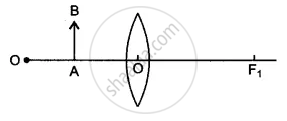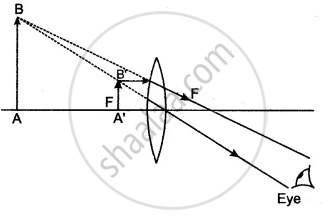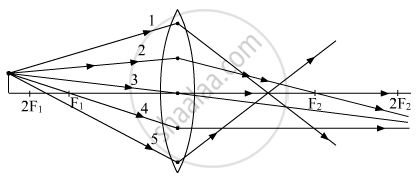Advertisements
Advertisements
प्रश्न
Diagram shows an object AB placed on the principal axis B of a convex lens placed in air. F1 and F2 are the two foci of the lens.

(i) Copy the diagram:
Draw a ray of light starting from B and passing through O. Show the same ray after refraction by the lens. Draw another ray from B which passes through F2 after refraction by the lens. Locate the final image
(ii) Is the image real or virtual?
उत्तर
(i)

(ii) Image is virtual.
APPEARS IN
संबंधित प्रश्न
Draw a labelled ray diagram to show how a ray of light is refracted when it passes:
from an optically denser medium into air.
What type of lens would you use as a magnifying glass? How close must the object be to the lens?
What is the position of image when an object is placed at a distance of 10 cm from a convex lens of focal length 10 cm?
A student did an experiment with a convex lens. He put an object at different distances 25 cm, 30 cm, 40 cm, 60 cm and 120 cm from the lens. In each case he measured the distance of the image from the lens. His results were 100 cm, 24 cm, 60 cm, 30 cm and 40 cm, respectively. Unfortunately his results are written in wrong order.
What is the focal length of this lens?
The focal lengths of four convex lenses P, Q, R and S are 20 cm, 15 cm, 5 cm and 10 cm, respectively. The lens having greatest power is :
(a) P
(b) Q
(c) R
(d) S
A convex lens is placed in water. Its focal length will ______.
Out of the five incident rays shown in the figure find the three rays that are obeying the laws of refraction and may be used for locating the position of image formed by a convex lens:
(A) 1, 2 and 3
(B) 2, 3 and 4
(C) 3, 4 and 5
(D) 1, 2 and 4
List four properties of the image formed by a convex mirror.
Which lens can produce a real and inverted image of an object?
